Research Domains
Polymer Functionalization
Polymers are the backbone of biomedical technology. The polymers do not have the required features for their application in bio and medical fields. This is where the selective modification of the biomaterial is needed. Following are the approaches for our ongoing functionalization technology towards biomaterial development. The inherent vision of polymer functionalization is to introduce specific properties such as biocompatibility, bioreceptivity, and biointeraction.
Radiation Grafting: Radiation grafting is one of the most interesting techniques to develop a graft copolymer structure by selective modification of the polymer. We developed polymers by graft polymerization of monomers such as methacrylic acid and N-vinyl pyrrolidone onto polyester.
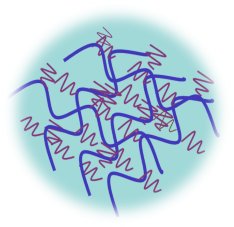
Graft copolymer
Plasma Grafting: Plasma treatment of polymer surfaces is being used to carry out nanoscale changes on the surface. The surface chemistry is being modified by using different gases in such a way that desired functional groups are created. In a more advanced stage, the plasma-activated surface is being grafted with different monomers so that a biocompatible and bioreceptive surface may be developed. The plasma activation is being used to develop materials for bioimmobilization and biocompatibility with the biological system
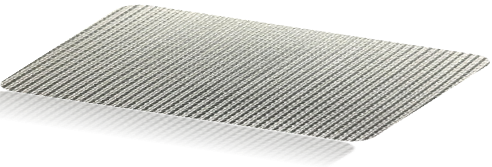
Plasma Functionalized PP mesh
Presently, we are working in the area of functionalization of polymer using plasma processing for infection-resistant implants for hernia treatment. This activity has been going on in collaboration with Prof. Amlan Gupta in collaboration with Sikkim Manipal Institute of Medical Science, Gangtok, Sikkim.
Suture Materials
Our group efforts were directed more in the area of Suture materials. The development of an antimicrobial suture based on nylon polypropylene, polyethylene, and polyester monofilaments is being pursued by graft modification or plasma functionalization of the sutures for the last ten years.
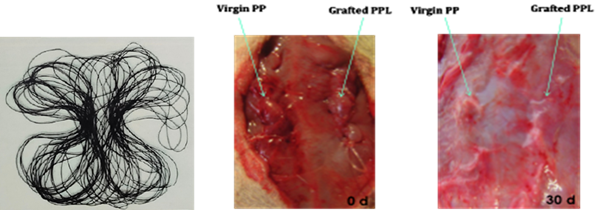
Antimicrobial polypropylene suture & suturing on mice model
The surface functionalization of the suture was carried out by plasma processing in such a way that the inherent characteristics, such as mechanical and knot strength of the suture are not affected. An antimicrobial drug is immobilized on the suture surface which is subsequently released into tissues surrounding the stitch and prevents microbial invasion. The tissue compatibility of these sutures is excellent and no adverse reaction has been observed against these sutures.
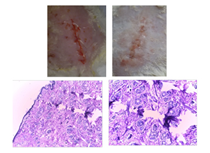
Wound healing performance and histological studies of PET sutures
Four patents are filed and more than six publications are published on the development of PP, PE, PET, and nylon based sutures and we are looking for technology transfer in this area.
Wound Dressing
The development of wound care systems is another area of the biotextile activities in the department. The aim of the present work is to develop wound dressings that are innovative in terms of comfort and performance. The wound dressing activity has been going on in collaboration with Dr. Surya Bhan, Department of Biochemistry, North-Eastern Hill University, Shillong. We designed and developed wound dressing materials based on biomaterials and herbal compounds so that the wound undergoes proper healing where scar formation is at the minimum.

Our new efforts are to develop wound dressings based on carrageenan, pectin, gelatin hydrogels for enhanced wound healing. The incorporation of drugs and essential oils into the dressings makes these dressings antimicrobial and help in control of infection around the wound. We have been able to produce a dressing which shows 98% scar prevention. Nanosoy reinforced dextran nanocomposite wound care membranes have been designed for scar free wound healing. Our subsequent studies are planned for the human trials very soon.
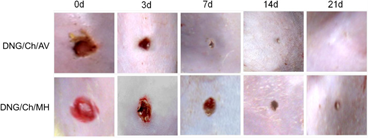
Scar preventive dextran-based bionanocomposite dressings containing aloe vera (AV) and manuka honey (MH) were developed as wound care devices.
We have also developed hydrogel wound care dressings based on Chitosan/PEG/PVP coated cotton fabric which have shown high porosity, good exudates absorption, air permeability, and required tensile strength. Wound dressings composed of natural polymers chitosan and carboxymethyl cellulose have been developed. These blend membrane shows enhanced activities and provides an optimal environment condition for the wound healing process.
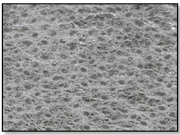

Porous structure of the freeze dried textile based dressing
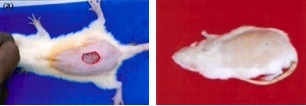
Animal test showing complete healing of wound using dressings
We developed composite material for wound dressing containing nanosilver nanohydrogels (nSnH) of polymethacrylic acid along with Aloe vera and curcumin that promote antimicrobial nature, wound healing and infection control. Nanosilver nanogel coated cotton base dressings have been developed by very simple procedures for rapid and scar free healing. The dressings are smart and have been designed in such a way that they offer minimum pain during their removal from the wound site. The animal tests have been extremely interesting. The dressings are biocompatible and show minimum tissue reaction.
Acne treatment: In a joint project with Indian Council of Medical Research (ICMR), we developed biopolymer based hydrocolloid patches for acne treatment. Acne patches (containing pectin and essential oils) have been proved excellent efficacy against microbes like P. acnes and S. aureus which are responsible for causing Acne vulgaris.
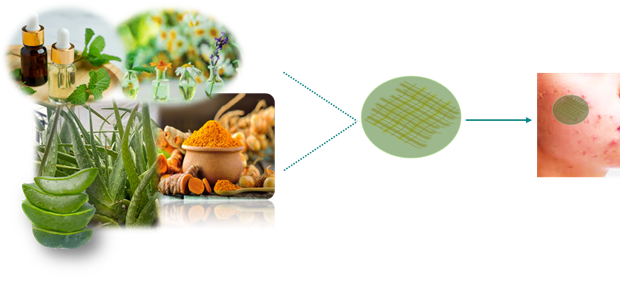
Essential oil loaded hydrocolloid based anti-acne patches
Smart Materials
The biomaterial activity is dedicated to the development of Smart systems for drug delivery applications. We have been able to develop hydrogels by radiation-induced copolymerization of various monomers with N-isopropyl acrylamide monomers into crosslinked structures. These materials offer the excellent ability for pH-sensitive or thermosensitive drug delivery in biological systems. The thermosensitive textile fabric has been developed which undergoes a phase transition at 37.5ºC so that this patch can be used for the transdermal drug delivery systems.
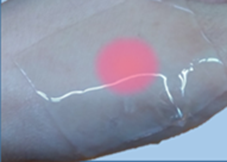
Transdermal Drug Delivery Patch
Our group worked on the fabrication and characterization of a pH and temperature-sensitive textile for transdermal drug delivery, based on gamma ray-induced graft copolymerization of acrylic acid/ N-isopropyl acrylamide on polypropylene nonwoven and polyester weaved fabric as a base material. These patches undergo drug release at a temperature that is higher than 37°C leading to the smart drug delivery application.

Schematic representation of thermosensitive textile materials
We worked in the area of smart materials, we have developed polyacrylic acid-based self-healing hydrogels. Hydrogel shows efficient self-healing within a very short span of time with excellent tensile strength properties.

Polyacrylic acid based self-healing hydrogels
Recently, we also worked on the biomaterial based pH-sensitive nanogels for anticancer drug delivery.
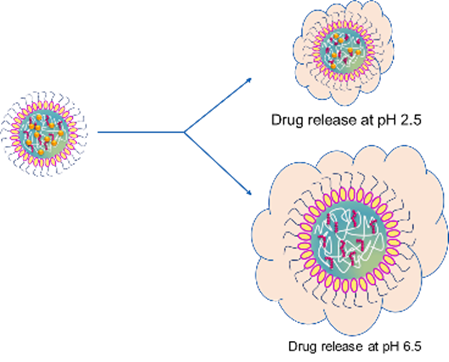
Tragacanth gum based pH-sensitive nanogels
Tissue Engineering
Tissue Engineering is the most fascinating domain where an alternative to the existing transplantation approach has been visualized. The medical textile group has made significant progress in the development of scaffolds for human urinary bladder reconstruction and cardio-vascular scaffolds in collaboration with the Swedish group.
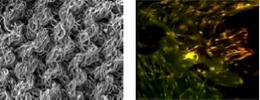
Biocompatible knitting
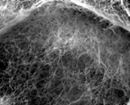
E-SEM Morphology of Collagen-PET Knitting
Our aim was to reconstruct blood vessels for vascular tissue engineering. We targeted the problems of Atherosclerosis and Aneurysm by designing biodegradable PCL-based scaffolds including textile knitting and braiding of less than 6 mm diameter followed by cell seeding on these scaffolds. These scaffolds were receptive and provided the proper environment for cell seeding.
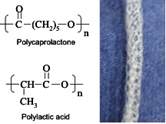
PCL/PLCL blend based Braided Tubular scaffold
DBT India and European Union have provided significant encouragement in the area of blood vessel development based on textile structures. Under these Programmes, the copolymers have been successfully spun into filaments of 30-40 microns which were elastic in nature and can be fabricated into a braided structure. The idea is to create a blood vessel by immobilization of biomolecules and growing cells from the healthy blood vessel on both sides of the braided scaffold.
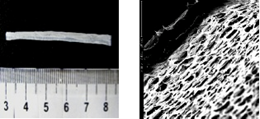
PCL based Porous Scaffold
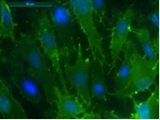
Endothelial cells on PCL Scaffolds
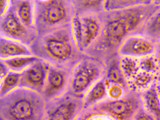
Cell culture studies on gelatin based electrospun mat for Vascular tissue engineering
In a Joint project between IIT Delhi and SMIMS, Gangtok under the NER-Twinning program of DBT India has provided significant encouragement in the area of skin tissue engineering. Under this project, we used gelatin as a scaffolding material for skin tissue engineering with the recent technique of electrospinning. The nanofibrous gelatin nanomats have been prepared and can be used viably as scaffolds for tissue engineering.

Cell culture studies of nanofibrous gelatin scaffold and proliferating keratinocyte cells
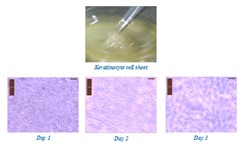
In this observation the cell sheet formation is an innovative feature of the study. The confluent culture layered over the scaffold by day 3 demonstrates the ability of the electrospun gelatin scaffold to provide topographical cues necessary for contact guidance. The progressive proliferation of the cells on the scaffold as seen by day 3 implies that the electrospun nonwoven structure of the scaffold has a nano dimensional architecture that offers a large surface area that favored cell attachment.
Infection Resistance Materials
We have been interested in the preparation of the nanohydrogels where nanosilver may be generated in-situ. The approach is to prepare w/o nanoemulsions where the hydrophilic monomer represents the water phase. The non-polar solvent acts as the oil phase. The polymerization is assisted by gamma radiation and the reduction of silver proceeds during the polymerization stage.
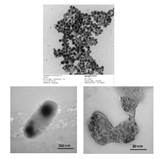
Nanosilver within nanogel structure and treated E. coli
Size-controlled preparation of soy protein isolate nanoparticles (nanosoy) has been done by using the nanoprecipitation method. Excellent control over protein aggregation was achieved, producing nanoparticles in the size range of 5–15 nm. The interest lies in the development of the functional nanogel which has the tendency to interact with the biomaterials surfaces and make them antimicrobial. Presently, we are working on the development of antimicrobial polyurethane urinary catheters by using functional nanomaterials.
Hemostatic Materials
Acute hemorrhage is the leading cause of mortality during military conflicts, traumatic injuries, and surgical interventions. Our interest lies in the development of biopolymer based hemostatic systems which have the potential of rapid blood clot along with antimicrobial properties. This activity has been going on in collaboration with Prof. Amlan Gupta in collaboration with Sikkim Manipal Institute of Medical Science, Gangtok, Sikkim.

Hemostatic dressing SEM image of blood clot on
Hemostatic Dressing
Size-controlled preparation of soy protein isolate nanoparticles (nanosoy) has been done by using the nanoprecipitation method. Excellent control over protein aggregation was achieved, producing nanoparticles in the size range of 5–15 nm. The interest lies in the development of the functional nanogel which has the tendency to interact with the biomaterials surfaces and make them antimicrobial. Presently, we are working on the development of antimicrobial polyurethane urinary catheters by using functional nanomaterials.
Herbal Therapeuticss
Chronic nonhealing wounds are a drain on healthcare resources and continue to challenge healthcare providers to define and create more effective intervention strategies. Thus, the scientific community is looking toward the science of life, Ayurveda. Various procedures, herbs, and dosages forms are enumerated in Sushruta Samhita for the management of wounds. The wound healing potential of plant decoction on chronic wounds conducted in a clinical study at All India Institute of Ayurveda New Delhi, which showed promising results.
In a Joint project between IIT Delhi and All India Institute of Ayurveda New Delhi (AIIA Delhi), we are developing a biopolymeric membrane for wound healing application along with infection resistance.

Herbal therapeutics